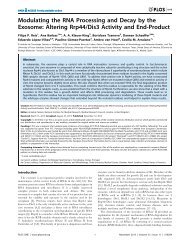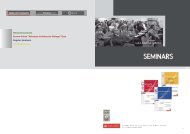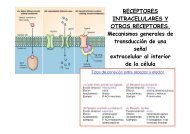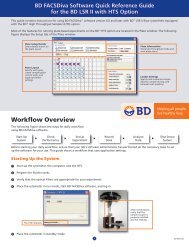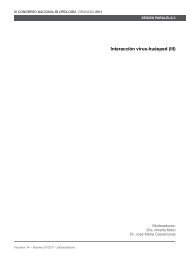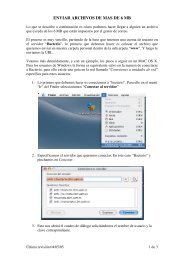Huygens Professional User Guide
Huygens Professional User Guide
Huygens Professional User Guide
You also want an ePaper? Increase the reach of your titles
YUMPU automatically turns print PDFs into web optimized ePapers that Google loves.
Biorad confocal microscopesTABLE 6. Biorad MRC600, 1024, RadianceBiorad MRC600/ 1024/RadianceReported parameter (p 8 )n.a.Size (diameter in mm) 0-8Pinhole geometrySystem magnification[Pawley 1995, p 30]Backprojected pinholeradius (nm) as function ofthe physical diameter d(mm)circular53-83, reported 60 for theRadiance, 53 for the 1024d ⋅ 10---------------------------------------62 ⋅ m system ⋅ mobj(EQ 11)Checking the Biorad system magnificationThe Biorad MRC500/600/1024 microscopes have a very high magnification in the detectionsystem. The fixed system magnification is according to Pawley [Pawley 1995, p 30] 53 × m tube ,m tube between 1.0 and 1.56 (a factor 1.25 for the ‘fluorescence attachment and also a factor1.25 for the ‘DIC’ attachment). The factor of 53 includes the 8× “eyepiece” just below the scanhead, but doesn’t include that variability in magnification due to the variations in tube-lengththat are result from the aligning the system.The high system magnification allows you to view the diffraction pattern (Airy disk) at the pinholeplane directly by eye. To enable you to verify the correctness of (EQ 11) in the table abovefor your instrument we outline the way the system magnification was derived:In a Biorad MRC600 with a 1.3 60x objective the Airy disk has a diameter of around 2-2.5mmat the pinhole plane. The diameter of the first Airy zero ring is 7.6 lateral optical units (o.u.),with a lateral optical unit v defined as:v =-----n sinαx 2πλ(EQ 12)with n sinα the numerical aperture. In the system above an o.u. is 0.3 ± 0.033 mm. At the specimenplane (backprojected) a lateral o.u. is in this case around 61nm. The total magnificationappears thus to be 4918, the system magnification 82 ± 9. This value corresponds well with thelargest possible system magnification for the MRC600.A supplied calibrationcurveIf a calibration curve was supplied with your microscope best use that curve to convert the displayedsetting to a physical size and from there convert to the backprojected radius.QuestionsWhat does the qualityfactor mean while running<strong>Huygens</strong>?Deconvolution as it is done in <strong>Huygens</strong> Pro hinges around the idea of finding an as good aspossible estimate of the object that is imaged by the microscope. To assess the quality of anestimate, <strong>Huygens</strong> Pro computes the image of each estimate as it would appear in the microscopeand compares it with the measured image. From the difference a quality factor is computed.The difference is also used to compute a correction factor to modify the estimate in sucha way that the corrected estimate will yield a better quality factor. The quality factor as26 The <strong>Huygens</strong> <strong>Professional</strong> <strong>User</strong> <strong>Guide</strong>



